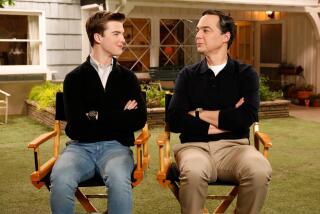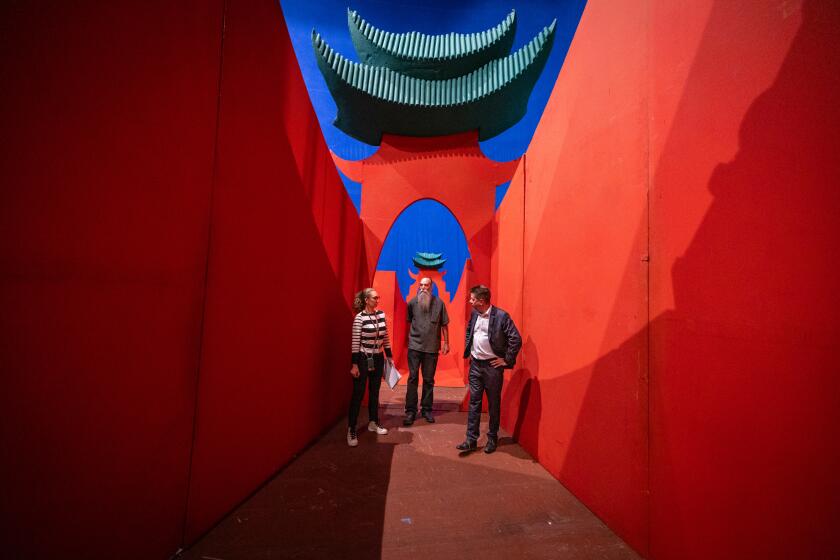Inspiring the Next Generation’s Hoofers
Hundreds of young children, many of whom may only have seen dance in the form of the animated mouse Angelina Ballerina on TV, gathered at the Music Center last month for their first taste--live--of the art form.
The free Family Day program was part of the Music Center’s presentation of American Ballet Theatre’s production of “Le Corsaire” (The Pirate) last month. In addition to the dance demonstrations by professionals and students, many youngsters also were treated to the matinee featuring the deft moves of 20 local dancers ages 11 to 17.
Dance, the art of moving in time through space, might seem too abstract or complicated for children. But choreographers and dancers say it’s one of the most child-friendly of the performing arts. One need understand only a few basic guidelines before navigating the dance waters with ease.
Kids at the “Corsaire” program, for instance, were wearing sneakers, not ballet slippers, as they were led through dance steps by former Joffrey Ballet dancer Carole Valleskey. The 9- to 11-year-olds took to the moves--truly more freestyle jazz than classical ballet--regardless. Valleskey, director of the in-school education program the California Dance Institute, said she started with simple moves, then put them to meter and asked for energy and focus.
After watching “Corsaire,” the children said their favorite thing was “watching Angel.” Soloist Angel Corella did appear to fly across the stage, mesmerizing everyone. Valleskey says, such virtuosity accounts for a large portion of ballet’s accessibility.
“The most important thing is to take children to quality stuff,” she said. “But for me, dance is the art form that’s the most accessible because it’s about what children do all day ...
It’s bodies moving through space, and they get that pretty easily.”
Still, parents need to prepare their children before going to a dance concert. She prepared her group for “Corsaire” by explaining a ballet company--what a corps is and what a soloist is, for example--and by leading students through simple choreography so they understood how steps are performed to meter and rhythm.
If ever a show was meant to be understood by children, it’s Walt Disney’s theatrical spectacle “The Lion King.” It won Tony Awards in 1998 for best musical and choreography and was based on a hugely popular children’s film.
The show’s success--it’s been running at the Pantages Theatre for nearly two years--is in part the result of the work of choreographer Garth Fagan. Speaking by phone from New York, Fagan said that he and director Julie Taymor conceived their work to be family-driven, and especially wanted to engage children.
“The movement is very exciting,” Fagan says, “and I decided to include all types of dancing in there--modern, ballet, African, Caribbean, hip-hop--so any and every child could plug into something that was their thing and learn something new about other forms of dance. You see kids in the lobby at intermission doing steps from the show.”
Sitting through a two-hour-plus musical might be difficult for a young child, but Fagan believes that children should be taken to dance performances at an early age. “The sooner the better,” he says emphatically. “Outdoor performances, where they can run around--that’s wonderful at any age. For indoor performances, I think about 4 years old, because their imagination is so fertile at that time.”
“Just be sure,” he adds with a laugh, “that they are trained for bathroom breaks and that they are old enough to be reasoned with.”
High-energy shows like “Blast,” which comes to UCLA’s Royce Hall this month, “Stomp” and “Riverdance” also have been a big draw for kids. Offshoots of tap-dancing, these shows get hearts pumping while putting the audience in a feel-good mood.
Lynn Dally, artistic director of Jazz Tap Ensemble, believes it’s not so much age that dictates when a youngster should be taken to dance concerts. They should go, she says, as soon as they can enjoy a performance.
“Really young kids are great to take to a casual format, where they can stand up and bounce around....They need some preparation for sit-down concerts. Remember,” she adds, “that kids are raised on TV and have very fast vision, so try to choose dance that’s visceral and visually compelling.”
That sounds a lot like tap dance, a form Dally can’t help but advocate. “Tap is so rhythmically engaging,” she says. “Kids really love hearing all the sounds. Tap conveys a feeling of ‘You can do this too.’ When kids come out of a tap concert, they usually come out stomping their feet.”
More to Read
The biggest entertainment stories
Get our big stories about Hollywood, film, television, music, arts, culture and more right in your inbox as soon as they publish.
You may occasionally receive promotional content from the Los Angeles Times.






